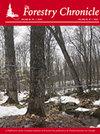Forest growth trends in Canada
IF 0.8
4区 农林科学
Q3 FORESTRY
引用次数: 4
Abstract
Reports have identified changes in abiotic factors that potentially affect forest growth. A synthesis of studies of thesechanges in Canada over the past century was undertaken to evaluate how these factors may be influencing forest growth.Reviewed papers used multiple sources of data including long-term inventory plots, tree-ring reconstructions, historicalgeographic data, and forest growth models. The synthesis showed that several positive growth trends were found inBritish Columbia and eastern Canada, while results from the western interior of Canada were mixed. Trembling aspen(Populus tremuloides Michx.) dieback has been noted due to severe and prolonged drought events, with growth reduc-tions and mortality also documented for conifers in the western interior. Studies have also found slow forest expansionin many areas and at the northern tree-line. Overall, authors attributed positive forest growth trends to rising CO₂ con-centrations, N deposition, increased precipitation, and increased temperature. Growth declines were generally attributedto a combination of increased temperatures and reduced precipitation. Studies also differed due to time periods consid-ered and how age effects were corrected. Methodological issues were identified that led to contradictory results betweensome studies. These issues need further study.加拿大森林生长趋势
有报告指出了可能影响森林生长的非生物因素的变化。对加拿大过去一个世纪的这些变化进行了综合研究,以评估这些因素如何影响森林生长。综述论文使用了多种数据来源,包括长期盘查图、树木年轮重建、历史地理数据和森林生长模型。综合数据显示,不列颠哥伦比亚省和加拿大东部出现了几个正增长趋势,而加拿大西部内陆地区的结果则喜忧参半。由于严重和长期的干旱事件,震颤白杨(Populus tremuloides Michx.)枯死已被注意到,西部内陆的针叶树也有生长减少和死亡的记录。研究还发现,许多地区和北部林木线的森林扩张缓慢。总体而言,作者将森林生长的积极趋势归因于二氧化碳浓度上升、氮沉降、降水增加和温度升高。生长下降通常归因于气温升高和降水减少的共同作用。由于所考虑的时间段以及如何纠正年龄影响,研究也有所不同。发现了导致一些研究结果相互矛盾的方法学问题。这些问题需要进一步研究。
本文章由计算机程序翻译,如有差异,请以英文原文为准。
求助全文
约1分钟内获得全文
求助全文
来源期刊

Forestry Chronicle
农林科学-林学
CiteScore
1.20
自引率
0.00%
发文量
6
审稿时长
18-36 weeks
期刊介绍:
The Canadian Institute of Forestry has published The Forestry Chronicle, a professional and scientific forestry journal, since 1925. The Forestry Chronicle is published to provide information to forest practitioners about professional and scientific management of forests and their resources. The Forestry Chronicle provides forest practitioners in Canada and around the world with a means to communicate with their peers in the professional community.
 求助内容:
求助内容: 应助结果提醒方式:
应助结果提醒方式:


